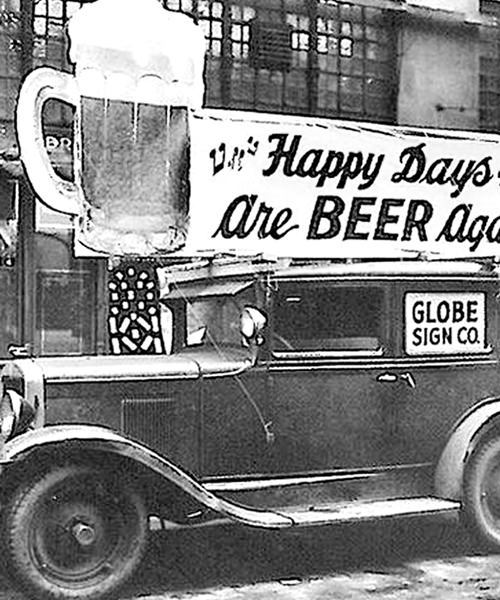We Americans have a complicated history with alcohol. It’s one that’s been deeply influenced by immigration, but also by xenophobia. For 13 years we didn’t allow the sale of alcohol at all, which lead to bootlegging priests and bootlegging rabbis. And then Prohibition was repealed and the real party started. The sale of beer officially became legal again on April 7, 1933. And the night before has been known ever since as New Beer’s Eve.
The 18th Amendment wasn’t repealed until Dec. 5, 1933. But nine months earlier, Franklin Delano Roosevelt signed an amendment allowing the manufacture and sale of beer with an alcohol content of 3.2 percent or less. Ending the booze drought had been one of Roosevelt’s campaign promises, and he was swift to keep it, signing the amendment after just months in office. That newly legal beer was hardly the stuff of today’s hoppy, 12 percent ABV craft beers. But it was a big enough difference that more than 1.5 million barrels were snapped up in the first 24 hours, according to the Brewers Association.
As is fitting, the president got the first batch. “At 12:04 A.M. today the great drought ended,” reads a New York Times article from April 7, 1933. “A shiny new beer truck, swifter if less picturesque than the brewers’ big horses of ante-bellum days, shot down Pennsylvania Avenue through a light Spring rain, stopped at the White House and delivered two cases of legal beer, addressed to President Roosevelt.” The truck bore a big sign announcing: “President Roosevelt, the first real beer is yours!” Though the President had long since retired for the night, the Secret Service accepted the delivery for him.
Don't Miss A Drop
Get the latest in beer, wine, and cocktail culture sent straight to your inbox.Out on the rainy streets of D.C., crowds gathered to watch. “Cheering Crowds Hail Beer Trucks Distributing New Brew,” reads another Times article from April 7, 1933. “JOLLITY REIGNS SUPREME.” With the strike of the clock at 12:01, the crowds cheered, motorists honked their horns, and sirens blared. “A new era in the nation’s social life was greeted joyfully in many cities,” The Times reported. There was markedly little “rowdyism,” and policemen dispatched to the area “instead found themselves protecting trucks, making deliveries at top speed, from accident and hijackers.” The capital led the way, followed by Philadelphia, Pittsburgh, Chicago, St. Louis, San Francisco, and Milwaukee. Hoboken speakeasies removed their screens and added tables to the now legal bars, though some were forced to change management.
Still, some areas were disappointed, like New York City. “New York was wet when beer became legal at midnight last night, but only with the rain,” reads another story in The Times. “The new 3.2 percent beer was not available until 6 o’clock this morning. Broadway, which had counted on a night of celebration and foam blowing, found itself with only the old bootleg beer to practice on, or none at all, though some hotels and night clubs had promised the real thing at the stroke of 12.” And this despite preparations, too. Police Commissioner Mulroney had 110 men in the theater district, ready “to augment the regular force in the event that the citizenry might require careful handling in the traffic after an excess of beer drinking, but the men were not needed.”
In some ways, New Beer’s Eve is the quintessential American holiday. We don’t always get it right, but when we don’t, we sure know how to fix it. So tonight, pour one out for our brothers and sisters who had to go 13 years without a drink, and the leader who realized this was no way to live, committed to fixing it, and did so within a month. There’s always hope. Cheers!
